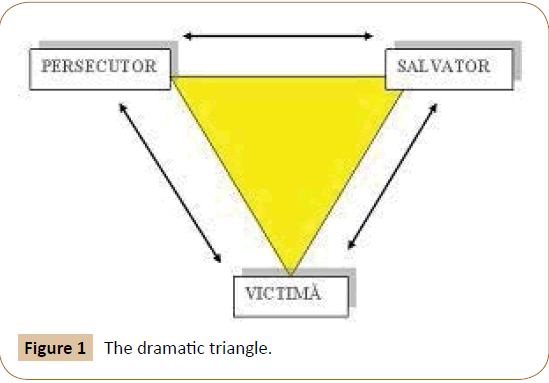The Dramatic Triangle and Addictive Attitude
Psychotherapist & Trainer NLP and INLPSI, Romania
- *Corresponding Author:
- Laura-Maria Cojocaru
Psychotherapist & Trainer NLP and INLPSI, Romania.
Tel: +0725161169
E-mail: psih_lauramaria@yahoo.com
Received date: April 16, 2018; Accepted date: April 20, 2018; Published date: April 25, 2018
Citation: Cojocaru LM (2018) The Dramatic Triangle and Addictive Attitude. J Psychol Brain Stud. Vol.2 No.1:7
Opinion
The Dramatic Triangle
(The Persecuter, The Savior and The Victim), systematized by Stephen Karpman, is a pattern of interaction in the psychological games specific to the Transactional Analysis, and unfolds as an unconscious and manipulative game we often resort to in order to fulfill some rather dysfunctional needs. It is a game of demand that is based on the belief that "it is proper to us" and at the same time it is a game of disregard (Figure 1).
The needs of each role are related to: attention, acceptance, support, help, respect, manifested love.
What disregards each role?
1. The Victim disregards his or herown resources and capabilities and the help received from others
2. The Persecutor disregards the freedom of others to decide
3. The Savior disregards the resources and capabilities of others
The Persecutor can resemble the Critical Father who accuses, attacks, injustices, is angry, and tells us that it is our fault only.
The Savior is the Considerate Father who helps us and takes our responsibilities, solves everything so the other could be calm and happy. The Savior does not save to do good, but because he feels the need to care for an addicted person who, if he is trying to become independent, is immediately transformed into the Persecutor.
The Victim is "the most important person," "the perfect manipulator," without it the Savior and the Persecuter would not justify their existence. The victim ("the poor / poor me ... what X or even everyone else has done to me!") is looking for three things: a person to support and take his/her responsibilities, a person to point your finger at when something goes wrong and a way to avoid taking responsibility for your own actions. The victim is the best "trainer", assuring his role in the lives of others, believing that he is justifying his own existence. This is about a very low self-esteem that he was trying to wrongly "lift" by manipulating the others. It is the painful truth about manipulation, especially sentimental, about creating addiction and entering into a vicious circle from which you can only get out wrinkled if not even crushed.
As in a play, the three roles change between them, the Victim always having the leading role. From this triangle no one comes out as a winner, all the protagonists have to lose, all suffer and the tragedy is that I do not even know why.
Example:
Victim: “You betrayed me, you deceived my trust, you do not care about me!”
The Savior: “I do not know why you are upset. Please tell me what I was wrong with. What have I done wrong?”
The victim: “Leave it, it's not your fault, anyway they have all betrayed me, and anyway I do not care about anyone or anything from now on” so he “takes his toys and leaves” because you did not guess, (because he does not say what he wishes for!) how he wanted you to act.
The Savior: "I wish your anger would pass. What can I do for you?"
The victim turns into Persecutor, giving the other one a guilty feeling: "It's too late now, there is nothing more left to do now, I do not care about you anymore."
The Savior then turnsinto the Persecutor: "I do not know how to be with you anymore, I have done everything for you, I understood you, I have been around you as many times as you needed ... because of you I have not slept all night and now I'm sick"
The victim, now feeling guilty, turns into the Savior: "Let's try to stop fighting; we are both tired, stressed, etc."
... and the dialogue can go on for ever, the protagonists changing their roles without being able to reach a meaningful conclusion, which inevitably leads to breaking the relationship, no matterthe nature it has.
If this triangle is made up of three people, for example a couple and a third person, or mother, father and child, the situation is even more difficult to master and suffering is as big as it can be.
How do we get out of the triangle:
By being aware of what we are doing and trying not to repeat the same mistakes while trying to get different results. We can choose not to feed the other's roles and break the relationship of addiction with the other and implicitly, the addiction to suffering. Any of the "characters" (especially the Victim) can consciously give up this role and can propose to live as self-sufficient person, to make their own decisions, to assume real responsibilities without being dependent on others.
For consciouslyexiting from this emotional triangle, it is enough to ask ourselves a simple question: "how else do I get what I need without playing one of these roles?" and let our imagination and creativity guide us to healthy ways of interacting with those around us and enjoy this interaction.
A simple answer to this question is: "I learn to offer myself and show the others how and what to offer me!"
What do we get by getting out of the triangle?
Giving up this psychological game allows accesing The Gift to each role:
1. The victim manifests compassion and forgiveness and mainly develops SQ (spiritual intelligence)
2. The savior manifests empathy and real dedication and mainly developsEQ (emotional intelligence)
3. The persecutor manifests will power, motivation and mainly developsIQ (mental intelligence)
The therapist's intervention can be:
1. By playing consciously for a short time the role of the other to reflect in the mirror the state he produces and then explain.
2. By asking questions that interrupt the person's metalanguage (exaggerated or unverified beliefs, generalizations, omissions, distorted interpretations of external events).
Example:
a. for the Victim: "how do you know you can’t do something without starting an action?", "how do you know that others do not understand you / help you without having patience to get help or not using the tools that they offer you and give them a chance for enough time?"
b. for the Savior: "how do you know that others can’t do without you?", "have they never managed to do something on their own?", "havethey never been able to find the solution themselves?", "how will others learn to do something if you do not help them?","Have you ever expected them to ask for themselves without you offering your help and being there to see what's going on?"
c. For the Persecutor: "Did you always do everything perfectly?", "Can you really please all the people, all the time?"
3. Reframing of context or meaning
Considering that two of the basic beliefs (more or less conscious) of these roles are "I ought to receive something from the others!" (from the demand perspective) and "the others do not know, cant, do not understand me , do not appreciate, do no good!"(from the perspective of disregard) the following reframings would be good:"Imagine you are alone on the planet, how do you live?"and "What would it be like if you started doing this for yourself starting now?"
Open Access Journals
- Aquaculture & Veterinary Science
- Chemistry & Chemical Sciences
- Clinical Sciences
- Engineering
- General Science
- Genetics & Molecular Biology
- Health Care & Nursing
- Immunology & Microbiology
- Materials Science
- Mathematics & Physics
- Medical Sciences
- Neurology & Psychiatry
- Oncology & Cancer Science
- Pharmaceutical Sciences

